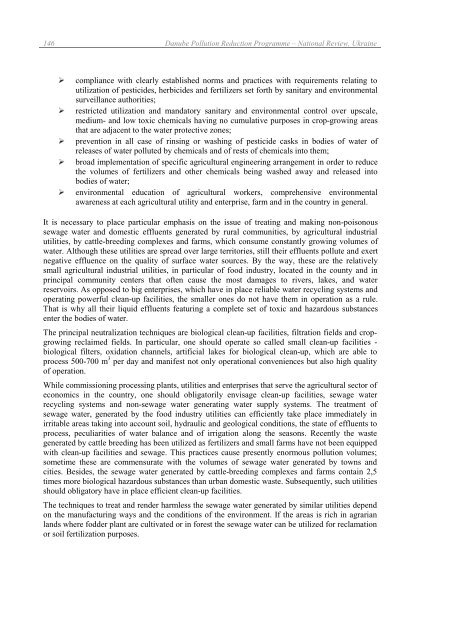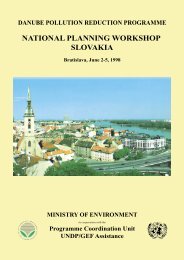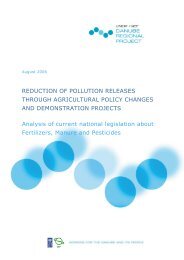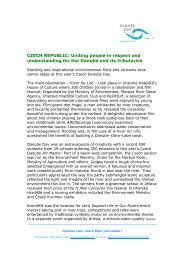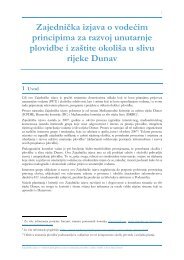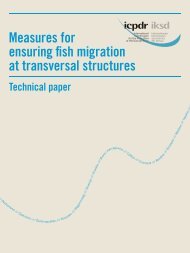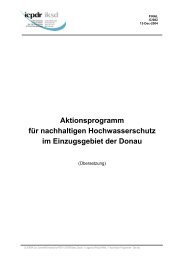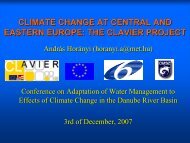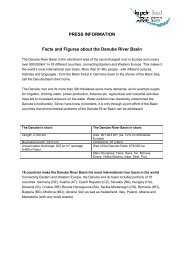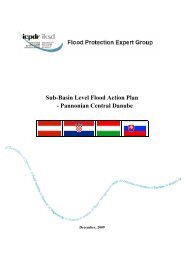Technical Reports Parts C,D - ICPDR
Technical Reports Parts C,D - ICPDR
Technical Reports Parts C,D - ICPDR
You also want an ePaper? Increase the reach of your titles
YUMPU automatically turns print PDFs into web optimized ePapers that Google loves.
146 Danube Pollution Reduction Programme – National Review, Ukraine<br />
<br />
<br />
<br />
<br />
<br />
compliance with clearly established norms and practices with requirements relating to<br />
utilization of pesticides, herbicides and fertilizers set forth by sanitary and environmental<br />
surveillance authorities;<br />
restricted utilization and mandatory sanitary and environmental control over upscale,<br />
medium- and low toxic chemicals having no cumulative purposes in crop-growing areas<br />
that are adjacent to the water protective zones;<br />
prevention in all case of rinsing or washing of pesticide casks in bodies of water of<br />
releases of water polluted by chemicals and of rests of chemicals into them;<br />
broad implementation of specific agricultural engineering arrangement in order to reduce<br />
the volumes of fertilizers and other chemicals being washed away and released into<br />
bodies of water;<br />
environmental education of agricultural workers, comprehensive environmental<br />
awareness at each agricultural utility and enterprise, farm and in the country in general.<br />
It is necessary to place particular emphasis on the issue of treating and making non-poisonous<br />
sewage water and domestic effluents generated by rural communities, by agricultural industrial<br />
utilities, by cattle-breeding complexes and farms, which consume constantly growing volumes of<br />
water. Although these utilities are spread over large territories, still their effluents pollute and exert<br />
negative effluence on the quality of surface water sources. By the way, these are the relatively<br />
small agricultural industrial utilities, in particular of food industry, located in the county and in<br />
principal community centers that often cause the most damages to rivers, lakes, and water<br />
reservoirs. As opposed to big enterprises, which have in place reliable water recycling systems and<br />
operating powerful clean-up facilities, the smaller ones do not have them in operation as a rule.<br />
That is why all their liquid effluents featuring a complete set of toxic and hazardous substances<br />
enter the bodies of water.<br />
The principal neutralization techniques are biological clean-up facilities, filtration fields and cropgrowing<br />
reclaimed fields. In particular, one should operate so called small clean-up facilities -<br />
biological filters, oxidation channels, artificial lakes for biological clean-up, which are able to<br />
process 500-700 m 3 per day and manifest not only operational conveniences but also high quality<br />
of operation.<br />
While commissioning processing plants, utilities and enterprises that serve the agricultural sector of<br />
economics in the country, one should obligatorily envisage clean-up facilities, sewage water<br />
recycling systems and non-sewage water generating water supply systems. The treatment of<br />
sewage water, generated by the food industry utilities can efficiently take place immediately in<br />
irritable areas taking into account soil, hydraulic and geological conditions, the state of effluents to<br />
process, peculiarities of water balance and of irrigation along the seasons. Recently the waste<br />
generated by cattle breeding has been utilized as fertilizers and small farms have not been equipped<br />
with clean-up facilities and sewage. This practices cause presently enormous pollution volumes;<br />
sometime these are commensurate with the volumes of sewage water generated by towns and<br />
cities. Besides, the sewage water generated by cattle-breeding complexes and farms contain 2,5<br />
times more biological hazardous substances than urban domestic waste. Subsequently, such utilities<br />
should obligatory have in place efficient clean-up facilities.<br />
The techniques to treat and render harmless the sewage water generated by similar utilities depend<br />
on the manufacturing ways and the conditions of the environment. If the areas is rich in agrarian<br />
lands where fodder plant are cultivated or in forest the sewage water can be utilized for reclamation<br />
or soil fertilization purposes.


